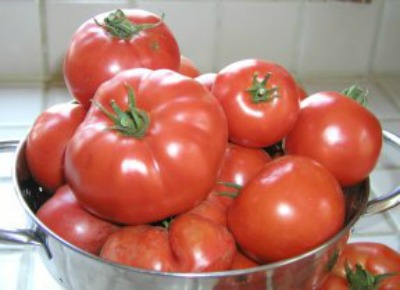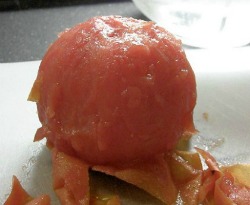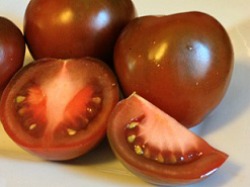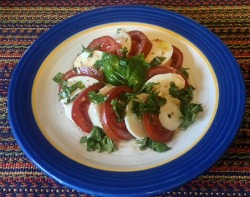Tomatoes – Learn About Tomatoes: Technically a tomato is a fruit, since it is the ripened ovary of a plant. In 1893, the supreme court ruled in the case of- “NIX vs. HEDDEN” that tomatoes were to be considered vegetables. There are more than 4,000 varieties of tomatoes, ranging from the small, marble-size cherry tomato to the giant ones that can weigh more than 3 pounds.
According to the U.S. Department of Agriculture, Americans eat more than 22 pounds of tomatoes every year. More than half this amount is eaten in the form of ketchup and tomato sauce.
History of Tomatoes:
Contrary to popular belief, tomatoes have been grown as a food since the 16th century, though they have in various times and places been regarded as both poisonous and decorative plants.
The Italian name for the tomato is pomodoro, meaning “apple of love” or “golden apple,” because the first to reach Europe were yellow varieties.
Tomatoes were not cultivated in North America until the 1700s, and then only in home gardens. In colonial America (1620-1763), tomatoes were thought to be poisonous and were grown as an ornamental plant called the “love apple.” The odor of the leaves made people think it was poisonous. Thomas Jefferson was raising tomatoes by 1782. Most people of that century paid little attention to tomatoes. Only in the next century did they make their way into American cookbooks, always with instructions that they be cooked for at least three hours or else they “will not lose their raw taste.”
1809 – According to the article from The Thomas Jefferson Society called Thomas Jefferson’s Favorite Vegetables by Peter J. Hatch regarding Thomas Jefferson (1743-1826), 3rd President of the United States:
Jefferson was a pioneer grower of “tomatas.” Beginning in 1809, he planted this grudgingly accepted vegetable yearly, usually in square X near the midpoint of the garden. Jefferson’s daughter, Martha, and daughters, Virginia and Septimia, left numerous recipes that involved tomatoes, including gumbo soups, cayenne-spiced tomato soup, green tomato pickles, tomato preserves, and tomato omelettes. Tomatoes were purchased in 1806 for Presidential dinners.
Fact, Legend or ???
Historians can not agree if the following story is fact, legend, or even a publicity stunt. The source of this story supposedly comes from an old farm journal. How much of this tale is true? Well, as with most legends, probably not much.
While there appears to be little substance to the legend, it is true that the tomato agriculture and related industry developed into the major economy in this area after the American Civil War (1861-1865) and were regarded as a kitchen vegetable and began to steadily grow in popularity. The first Fanny Farmer cookbook, which appeared in the late 1890s, included recipes for tomato soups, salads and sauces without cautions or reservations.
The CBS television series You Are There even dramatized the story on January 30, 1949 in the story called “Colonel Johnson Eats The Love Apple,”creating the peculiar situation of our being there while Johnson wasn’t.
1820 or 1830? – In September of either 1820 or 1830 (the year varies with different accounts), legend has it that Colonel Robert Gibbon Johnson (1771-1850) purportedly introduced the tomato to Salem County, New Jersey. Despite warnings that the tomato’s poison would turn his blood to acid, he told the cheering spectators that he planned to eat the entire basket and survive. The story goes that thousands of eager spectators turned out to watch Johnson die after eating the poisonous fruits, and were shocked when he lived. Supposedly Colonel Johnson recited this speech:
The time will come when this luscious, scarlet apple…will form the foundation of a great garden industry, and will be … eaten, and enjoyed as an edible food…and to help speed that enlightened day, to prove that it will not strike you dead – I am going to eat one right now!
Colonel Johnson’s physician, Dr. James Van Meter, supposedly warned that:
The foolish colonel will foam and froth at the mouth and double over with appendicitis. All that oxalic acid, in one dose, and you’re dead. If the Wolf Peach [tomato] is too ripe and warmed by the sun, he’ll be exposing himself to brain fever. Should he, by some unlikely chance, survive, I must warn him that the skin…will stick to his stomach and cause cancer.
False Memories: The Invention of Culinary Fakelore and Food Fallacies, Proceedings of the Oxford Symposium on Food and Cookery 2000, by Andrew F. Smith:
Robert Gibbon Johnson was a prominent Salemite and much was written about him. Unfortunately, I found no evidence connecting him to the tomato. The first version of the story appeared in print 86 years after the purported event. All it said was the Johnson ate a tomato in 1820. Subsequent authors embellished the story adding extraneous information and the purported event was dramatized on national radio in 1949. Subsequently versions have appeared in numerous professional and scholarly journals, newspapers, and popular magazines.
Purchasing Tomatoes:
Go Local if possible – Tomatoes do not become more flavorful and develop adequate flavor unless allowed to ripen on the vine. They will change color and soften, but the sugar, acid, and aroma compounds are locked in once the fruit is taken off the vine. So, choose vine-ripened tomatoes, preferably locally grown, because the less the tomatoes have to travel, the more likely they were picked ripe. Seek out locally grown tomatoes whenever possible. They may not be as “pretty” as store bought, but beauty, of course, is only skin deep.
Selecting Tomatoes: Select tomatoes that are firm, glossy, smooth, plump, heavy for their size, and free of bruises. Avoid tomatoes that are overly ripe and soft.
Fragrance is a better indicator of a good tomato than color. Use your nose and smell the stem end. The stem should retain the garden aroma of the plant itself – if it doesn’t, your tomato will lack flavor and, as far as I’m concerned, will be good only for decoration! Remember – If the tomato smells fresh and tomato-y, they will taste that way too!
Since fresh tomatoes are summer fare and off-season tomatoes are rarely flavorful, substitute good-quality canned Italian plum tomatoes in cooked dishes. Cook for ten minutes to reduce the liquid and enhance the taste.
Storing and Ripening Tomatoes:
Storing Ripe Tomatoes: NEVER REFRIGERATE FRESH TOMATOES! Cold temperatures make the flesh of a tomato pulpy and destroys the flavor. Always store tomatoes at room temperature stem-end down. This prevents air from entering and moisture from exiting its scar, prolonging shelf life.
How To Ripen Green Tomatoes: To ripen, place green tomatoes in a brown paper bag and place in a dark spot for three or four days, depending on the degree of greenness. The bag will trap the fruit’s ethylene gas and encourage ripening. Do not put tomatoes in the sun to ripen – this softens them.
Preparing Tomatoes:
The Right Knife: A serrated knife makes slicing through the skin easier. This way you do not inadvertently mash your tomatoes when slicing. If you are using a straight blade, make sure it is very sharp.
To Seed or Not To Seed: The flavors of a tomatoes are not just in its flesh, as the skin has a slight bitterness, while the flesh contributes the sugars and amino acids, and the jelly and juice surrounding the seeds contribute acidity. However, the seeds and surrounding jelly will contribute liquid to the dish you are using it in, which can make uncooked dishes, such as salsa, too watery. The tomato skins also have a way of curling up into tough little bits when they are cooked. If the seeds and skins will not be noticeable in a dish, keep them in. If you are making a smooth sauce, you can always strain out the seeds and skins later as the skins and seed will add flavor.
How To Seed Tomatoes: Cut them in half lengthwise, then use your fingers to scoop out the seeds. Give the tomato a gentle squeeze to remove any stragglers. NOTE: You can also strain out the seeds and use the liquid and jelly in your recipe. In that case, scoop the seeds into a fine-mesh sieve set over a bowl to catch the juices.
Preserving Tomatoes:
Freezing Tomatoes: The simplest way to preserve tomatoes is to freeze them whole. Just rinse them, spread them out on a cookie sheet, and freeze overnight. When frozen, put them in a freezer bag and return to the freezer. To use, remove from bag and thaw. When thawed, slip the skins off, and use in your favorite recipes.
Puree Tomatoes: Peel the tomatoes, puree them in a blender, and then strain them through cheesecloth or a coffee filer to drain off the excess tomato water (this can be used in soups). Freeze the pulp in ice cube trays. When frozen, store the frozen cubes in a freezer bag.
Oven Roasted Tomatoes: Roast halved tomatoes with olive oil and herbs before freezing.
 How To Peel Fresh Tomatoes:
How To Peel Fresh Tomatoes:
Learn how easy it is to peel fresh tomatoes with this How To Peel Fresh Tomatoes Photo Tutorial.
Tomato Equivalents:
Fresh Tomatoes:
1 cherry tomato weights appx. 1 ounce and equals about 1 tablespoon.
25 to 30 cherry tomatoes = 2 cups chopped tomatoes.
1 plum tomato weighs appx. 2 to 3 ounce and equals about 1/3 cup.
1 small tomato weights 3 to 5 ounces and equals about 2/3 cup.
1 medium tomato weight 5 to 6 ounces and equals about 3/4 cup.
1 large tomato weighs 7 or more ounces and equals about 1 1/4 cups.
2 1/2 pounds fresh tomatoes = 3 cups chopped and drained fresh tomatoes = 2 1/2 cups seeded, chopped cooked tomatoes.
1 pound fresh tomatoes = 3 cups pureed tomatoes.
Canned Tomatoes:
1 (16-ounce) can = 2 cups undrained tomatoes = 1 cup drained tomatoes.
1 (28-ounce) can = 3 cups undrained = 2 to 2 1/2 cups drained tomatoes.
1 (35-ounce) can = 4 cups undrained = 2 1/2 to 3 cups drained tomatoes.
1 (6-ounce) can tomato paste = 1/4 cup.
Tomato Tips:
Add a pinch of sugar to tomatoes when cooking them. It enhances the flavor.
To keep baked or stuffed tomatoes from collapsing, bake in greased muffin tins. The tins will give them some support as they cook.
Tomato “water” – the clearish liquid that dribbles out of a sliced tomato, can be used as a low-acidity stand-in for lemon juice. This can be used in marinating raw fish.
Lots of delicious Tomato Recipes.
KUMATO Tomatoes:
Kumato tomatoes differ from the traditional red tomato in color and taste. The color of a Kumato tomato varies from a dark brown to a golden green color. They are also sweeter (contain a higher brix) than normal tomatoes with a more intense flavour and are juicy with a firm texture. These tomatoes are edible in all different color growth stages. Perfect to serve in salads and other tomato based recipes. Kumato tomatoes are not genetically modified, they were developed through traditional plant breeding techniques and natural cultivation methods.
Where can I find Kumatos: It is common to find Kumatos produced and distributed in Western Europe, Australia and now Kumatos are starting to be produced in Mexico. Kumatos can now be found in high-end or health-food grocery stores in the United States.
Origins of the Kumato Tomato: The actual name of the tomato variety which originated in Spain is called “Olmeca”. Kumato is the trade name. In Canada, this variety is also known as Rosso Bruno.
“In the 1970s, Luis Ortega would often go with his father to the fields cultivated by his family in the village of Agra, on the Almerian coast. His curiosity led him to discover that the tomatoes at the end of the lines, which received less water, were a different colour, but were much more intense and sweet in flavour. Having observed this, the young farmer set himself a personal challenge – to grow a tomato with an authentic and intense flavuor that was a different colour. This was how the Kumato tomato was born, on the shores of the Mediterranean.”
How should Kumato tomatoes be stored:
All Kumato tomatoes are vine-riped and picked when ready to eat. They can be stored at room temperature for up to two weeks after they are picked. It is not recommended to refrigerate, or they will lose their natural sweetness. Once the Kumatos are sliced, they should then be refrigerated in a sealed container.
Can I get seeds to grow Kumato tomatoes: Seeds cannot be purchased by the general public. The Syngenta Corporation keeps tight control over distribution of the seeds to select licensed growers who follow strict cultivation guidelines. “As Kumato is a hybrid tomato, planted seeds will not grow plants identical to the parent.” There is speculation out there on the internet that this variety is not a hybrid at all but a open pollinated variety that can be grown from the parent seed. Grower’s claim that Syngenta publicized this variety as a hybrid to deter home gardeners from trying to grow this variety. Many home growers are claiming that the seeds from the parent plant are growing true to form and taste. You can try drying the seeds from Kumato’s, grow for yourself and be your own judge.
References:
Wikipedia, Kumato
Syngenta Agri Business Global
Tomato Addict Blog


 How To Peel Fresh Tomatoes:
How To Peel Fresh Tomatoes:
